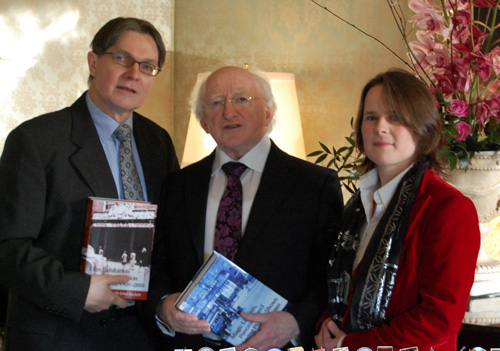Trinity Academic Explores Development of Popular Visual Culture in Ireland in Two New Publications
Posted on: 06 February 2012
Two new books, Magic Lantern, Panorama and Moving Picture Shows in Ireland, 1786-1909 and Film Exhibition and Distribution in Ireland, 1909-2010, provide a fresh context for understanding the development of popular culture, including cinema, in Ireland. To mark the publication of the books the authors, Professor of Film Studies at Trinity’s School of Drama, Film and Music, Kevin Rockett, and his wife Emer, were recently invited by President Michael D. Higgins to visit Áras an Uachtaráin.

Professor Kevin Rockett, President Michael D. Higgins and Emer Rockett at Áras an Uachtaráin.
In Magic Lantern, Panorama and Moving Picture Shows in Ireland, 1786-1909, the authors demonstrate that prior to the opening of Ireland’s first cinemas at the end of the first decade of the twentieth century, there were already huge numbers of people in Ireland, from all classes, regularly enjoying proto-cinematic experiences through such entertainments as magic lantern, or slide projector shows; exhibitions of immersive large-scale, and, at times, moving paintings known as panoramas; and tableaux vivants, or theatrically posed static representations of paintings, statues and events. Without these cultural forms, many developed by Irish inventors and pioneers, not only would cinema’s moving-pictures have been unimaginable, but so, too, would the physical spaces and locations in which films came to be screened in Ireland.
Film Exhibition and Distribution in Ireland, 1909-2010, traces in forensic detail the social, cultural and business practices that comprise the Irish cinema phenomenon by utilising a range of previously unexplored primary sources from film trade publications to cinema records. The book, which provides the first extensive account of a whole Irish business sector, offers the first in depth histories of the competing cultural and moral agendas of the secular Irish Film Society and the Catholic-controlled National Film Institute of Ireland as well as outlining the emergence of a dynamic film culture from the 1970s. The book concludes by presenting annotated all-Ireland listing of film exhibition venues from the first film screenings in Ireland in 1896.
In 2004, President Higgins launched the first of the Rocketts’ books in this trilogy on picture-going in Ireland, Irish Film Censorship: A Cultural Journey from Silent Cinema to Internet Pornography, which was awarded an American Library Association prize for Academic Excellence. All three books were published by Four Courts Press.
About the Authors:
Kevin Rockett is a Professor of Film Studies at Trinity’s School of Drama, Film and Music. He has authored, co-authored or edited thirteen books, including the award winning Irish film censorship: a cultural journey from silent cinema to internet pornography (2004). He also co-authored the first academic study of Irish film history and representations of the Irish in British and American cinemas, Cinema and Ireland (1987); is director of Trinity College’s Irish Film & Television Research Online (www.tcd.ie/Irishfilm); and received the Irish Film Institute award for Contribution to Irish Film in 2001.
Emer Williams Rockett has taught film studies at University College Dublin, National College of Art and Design, Dún Laoghaire Institute of Art, Design and Technology, and on New York University’s Dublin film programme. She has written on or presented papers on Irish cinema, the body and technology, and on the visual arts, while her research interests include cultural theory and early cinema. Emer has worked with her husband Kevin on numerous projects including Irish film censorship: a cultural journey from silent cinema to internet pornography (2004) and Neil Jordan: exploring boundaries (2003).
